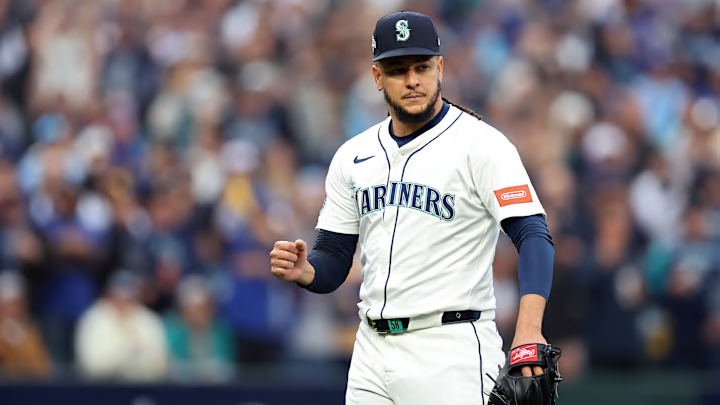For the Mets, the conversation always comes back to the same question: are you serious about shortening the gap between “interesting” and “contender,” or are you just rearranging the infield dirt? All the complementary adds in the world don’t change the fact that a true frontline arm still separates New York from the tier they keep insisting they belong in. That’s where Luis Castillo’s name creeps in.
He’s not the shiny new toy; he’s the proven, playoff-tested arm with a workhorse track record and swing-and-miss pedigree, the kind of acquisition that signals Steve Cohen isn’t just spending, he’s aligning money, years, and risk on someone who can anchor October. If the Mariners are even mildly open for business on Castillo, the Mets at least have the pieces to make Seattle stop and listen.
On the other side, the Mariners are living in the uncomfortable middle ground between “we built a rotation most teams envy” and “we absolutely cannot score enough.” They’ve got payroll commitments to stars, looming decisions on how aggressively to fix an offense that has lagged behind their pitching, and a fanbase tired of timelines. Moving Castillo would be a seismic message.
But it could also be the kind of cold-blooded, resource-rebalancing move front offices talk themselves into: dealing from rotation strength to attack the black hole at third, first, and possibly second. If the return package offers controllable offensive upside and buys financial flexibility, Jerry Dipoto and company at least have to take the call.
The kind of Mets offer that makes the Mariners listen on Luis Castillo
Start with Castillo. The “he’s slipping” narrative is only half-baked. Yes, he’s no longer nuking lineups purely with strikeout volume, and stretches of diminished changeup feel have forced him to lean more heavily on his four-seamer/two-seamer mix. But an 11–8 record with a 3.54 ERA and 162 strikeouts over 180 2/3 innings still screams reliability.
He’s under a substantial but not paralyzing contract: two more guaranteed years at frontline money plus a vesting option — the kind of deal that fits only in markets willing to spend and to pay in talent. For the Mets, he’d instantly slot near the front of the staff and absorb real innings. For the Mariners, that contract is both security and leverage: they do not have to move him, and that alone drives the ask.
Enter the Mets’ proposed framework: Mark Vientos and Ronny Mauricio as the core of a Castillo package. On paper, it maps cleanly onto Seattle’s needs. The Mariners have glaring uncertainty at the corner infield spots and a need for more impact threats who can grow with their core. Vientos brings legitimate right-handed thump; even in a frustrating 2025, he popped 17 homers with above-average raw power metrics that suggest more if he irons out approach and finds consistent run.
Mauricio (.226/.293/.369, 6 HR, 10 RBIs) offers switch-hitting versatility, athleticism, and a history of loud contact when right, but he’s still searching for timing, reps, and full health after losing 2024 and grinding through 2025 post-ACL. Both are “prove-it” candidates with once-premium prospect labels, both blocked to varying degrees in Queens, and both feel like classic change-of-scenery bets. For Seattle, that’s high-upside, controllable infield help at a moment they badly need it.
But the realism check cuts both ways. From the Mariners’ side, Castillo is not a distressed asset you flip just to free dollars or chase lottery tickets. He’s a bankable rotation pillar on a team that still sells run prevention as its identity. If they move him in a package centered on Vientos and Mauricio, the path to justification doesn’t necessarily run through demanding a third or fourth headliner — it runs through the money.
Seattle may prefer a structure where the Mets take on the bulk of Castillo’s remaining salary, effectively turning one expensive arm into two controllable bats while freeing meaningful room to make an additional splash in free agency or the trade market. In that version, the return isn’t just Vientos plus Mauricio on paper; it’s Vientos, Mauricio, and the financial runway to add another impact piece.
From the Mets’ angle, simply treating Vientos and Mauricio as expendable undersells their internal value. Both still project as potential everyday contributors or useful trade chips in larger, more premium packages. Mauricio’s timeline, age, and past prospect pedigree make it hard to imagine New York selling low unless they’re convinced his path is blocked and his ceiling has cratered.
Vientos’ power is real enough that a patient club could still unlock a 30-homer bat. If the Mets are taking on Castillo’s contract and paying in upside, they will rightfully expect Castillo to be a top-of-the-rotation stabilizer through the life of that deal — and they’ll push to keep the package just short of gutting their next wave. That tension is exactly why this kind of deal is so tricky to line up.
In the end, a Castillo-to-Mets framework built around Vientos and Mauricio is more intriguing than outlandish: it attacks Seattle’s infield need, leverages New York’s positional surplus, and fits Cohen’s willingness to buy big arms when they become available.
This is the kind of deal that makes sense as a conversation starter, not the last page of the script, and it underscores the broader truth for both clubs: if either side moves an ace or a core bat, it has to hurt a little, or it’s not real.
